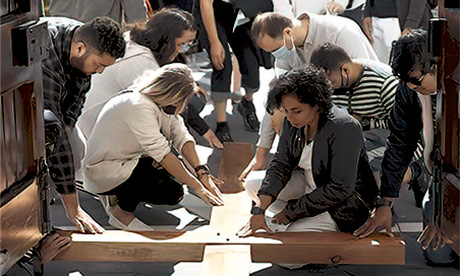“We’re back,” was the reaction of one parish priest to the swelling congregations at Easter services.
The priest with four churches in the parish told CathNews that all the main services at prime times were full.
“I always knew people would come back”, he said in an uplifted tone.
“I nearly had to erect a sign, ‘No room at the Inn’, but it’s the wrong season for that,” he said, grinning with delight.
A similar upbeat tone was reflected by parishes CathNews contacted throughout the country. In one, the ‘crowd controller’ at St Anne’s Manurewa, Auckland, estimated the congregation numbered around 2,000, swamping available seating inside the church.
The feeling was catchy.
In Johnsonville, Jigs (16) assisted, as the priest sprinkled the bulging Easter Sunday congregation with water.
“The church couldn’t cope with the number; people overflowed into the foyer, and we ‘almost’ ran out of holy water”, Jigs told CathNews.
Gillian and Ewen said the Easter ceremonies lifted their spirits.
“People just kept on coming; there’s life after all.”
“People left their tombs; it was a resurrection experience happening before our eyes,” Ewen said.
JL (18) breathed a sigh of relief as he described what he called ‘normality after two years.
“It was way more lively and great to see the community come out and celebrate the Resurrection of Jesus Christ,” he said.
“The community is bigger than our locked-down individual efforts.”
Judy described the ceremonies as “Spring in Autumn.”
Not one for TV Eucharist, she told CathNews that, for her, “Church is about being together, not watching others eat and drink.”
“Eucharist is a community in action, not a spectator event,” she said.
Judy says she likes to go to Mass and considers herself ‘a regular’, but confessed she is not the most organised and, because of the booking system, she regularly missed out.
“Whoever thought that for two years, we’d have to book to go to Mass!”
She said that she probably prayed a bit more in the intervening times than she once did but did not consider that a bad thing.
“But personal prayer is not community worship. It’s different.”
“Young families.
“New life.
“Optimism,” she said.
The palpable confidence of all these parishioners was catchy. It was real and while some, for example, missed kissing the cross on Good Friday and others regretted there was no singing, all wanted to focus on the positive. Their Easter joy was overlayed with being sensible.
“As well as the Resurrection, people also had an eye on the rear-view mirror; the tomb,” Jane told CathNews.
“They showed their care and respect for each other by being masked and using hand sanitiser.
“It gave me more confidence to be there,” she said.
Australia
Easter positivity also permeated Australia, where more than 8,000 people filed through the doors of St Patrick’s Cathedral in Melbourne.
Melbourne’s Catholic Archbishop Peter Comensoli described the peoples’ response as “humbling after COVID-19 density limits, and live streaming had dominated the event in recent years.”
The Age reports that Cathedral staff went a step further than the norm and introduced hand sanitiser before receiving Holy Communion.
Not all over
However, despite the optimism, New Zealand’s Dr Dion O’Neale of Covid-19 Modelling Aotearoa warns ‘it’ is not all over, and the next Covid-19 wave could hit New Zealand as early as winter or spring.
He cautions that the shape and timing of the next wave hinge on big uncertainties – such as how fast our natural immunity will wane, and whether our own behaviour will boost the spread.
Identifying the importance of continuing to use of masks, O’Neale says that future waves should have lower peaks, but qualifies the comment by saying the lower peaks depend on peoples’ behaviour.
He says a fourth vaccine for high-risk groups would be a good way to mitigate the health burden with future waves.
O’Neale says “Overseas data on reinfections suggests that it is dominated by infections in unvaccinated individuals – particularly in younger children who may be too young to be vaccinated and who have lower vaccination coverage in general.”
He is also not ruling out another ‘game-changing’ variant.
On April 13, New Zealand’s Covid Response Minister announced that at 11:59 pm the country would move from red to the orange traffic light setting.
Additional sources
